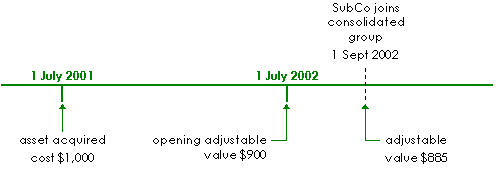Consolidation Reference Manual
You can still refer to the Consolidation reference manual for consolidation information that has not been impacted by changes in the legislation.
C9 Tax liabilities
C9-5 Worked examples:
C9-5-315 Capital allowances - without accelerated depreciation
Description
This example illustrates the treatment for capital allowances purposes of a depreciating asset brought into a consolidated group by a joining subsidiary and to which accelerated depreciation does not apply.
Commentary
When an entity becomes a member of a consolidated group the tax costs of its assets are set under the cost setting rules (other than when the transitional option of retaining existing tax values has been applied).
When the tax cost of a depreciating asset is set, certain capital allowances provisions [F1] apply as if certain things had happened in relation to the asset's date of acquisition and cost at that date, the method used for working out the asset's decline in value, and its effective life. → paragraphs 701-55(2)(a), (b) and (e), Income Tax Assessment Act 1997 (ITAA 1997).
These deemed occurrences override the entry history rule. → 'Introduction to consolidation', B0-2
Example
Facts
SubCo, a 90%-owned subsidiary of HeadCo, acquires depreciating Asset B on 1 July 2001 at a cost of $1000. SubCo chooses to use the Commissioner's determination of effective life of 10 years and also chooses to work out the asset's decline in value using the prime cost method.
HeadCo chooses to consolidate on 1 July 2002.
On 1 September 2002, HeadCo acquires the remaining 10% of SubCo's shares, bringing SubCo into the consolidated group.
The adjustable value of Asset B in SubCo's hands just before it joins the consolidated group is $885. → figure 1
Figure 1

The adjustable value just before the joining time is Asset B's terminating value. → subsection 705-30(3), ITAA 1997
HeadCo works out a tax cost setting amount for Asset B of $880 under Division 705 of the ITAA 1997.
Capital allowances treatment
When HeadCo sets the tax cost of Asset B the capital allowances provisions operate as if:
- •
- HeadCo acquired Asset B on 1 September 2002 for a payment equal to its tax cost setting amount of $880
- •
- the prime cost method were chosen, and
- •
- an effective life were chosen equal to Asset B's remaining effective life at the joining time, i.e. 8.83 years (because Asset B's tax cost setting amount does not exceed its terminating value).
→ paragraphs 701-55(2)(a), (b) and (c), ITAA 1997
For the 2003 income year, HeadCo will calculate Asset B's decline in value under subsection 40-75(1) of the ITAA 1997 as follows:
$880 * (303 days / 365 days) * (100% / 8.83 years) = $83
rounded
Variation on the facts
Assume the same facts as above, except that HeadCo works out a tax cost setting amount for Asset B of $890.
As the tax cost setting amount for Asset B exceeds its terminating value of $885, paragraph 701-55(2)(d) applies.
Paragraph 701-55(2)(d) requires HeadCo to make a choice about the effective life for Asset B under subsections 40-95(1) and (3).
Under subsection 40-95(1) of the ITAA 1997, taxpayers can choose to use an effective life determined by the Commissioner or, alternatively, work out an effective life for themselves under section 40-105 of the ITAA 1997.
If HeadCo chooses to use an effective life determined by the Commissioner, paragraph 701-55(2)(d) limits this to an effective life in force at the joining time.
If HeadCo chooses to work out an effective life for itself, it may decide on a longer or shorter period than the remaining effective life, depending on its view of the factors in section 40-105.
References
Income Tax Assessment Act 1997, sections 40-75, 40-95, 40-105
Income Tax Assessment Act 1997, sections 701-5, 701-10 as amended by New Business Tax System (Consolidation) Act (No. 1) 2002 (No. 68 of 2002), Schedule 1
Income Tax Assessment Act 1997, sections 701-55, 701-80, 705-30, 705-45; as amended by:
- •
- New Business Tax System (Consolidation) Act (No. 1) 2002 (No. 68 of 2002), Schedule 1
- •
- New Business Tax System (Consolidation, Value Shifting, Demergers and Other Measures) Act 2002 (No. 90 of 2002), Schedule 2
- •
- Taxation Laws Amendment Act (No 8) 2003 (No. 107 of 2003), Schedule 2, item 1.
Income Tax (Transitional Provisions) Act 1997, section 701-15; as amended by New Business Tax System (Consolidation, Value Shifting, Demergers and Other Measures) Act 2002 (No. 90 of 2002), Schedule 7
Income Tax Assessment Act 1936, section 318
History
Revision history
Section C9-5-315 first published 2 December 200 and updated 28 May 2003.
Further revisions are described below.
| Date | Amendment | Reason |
|---|---|---|
| 23.12.03 | Clarification of the rules on effective life including removal of the unexpected consequences of choosing effective life. | Reflects amendments to ITAA 1997, paragraph 701-55(2)(d), by Taxation Laws Amendment Act (No. 8) 2002 (No. 107 of 2003). |
Proposed changes to consolidation
Proposed changes to consolidation announced by the Government are not incorporated into the Consolidation reference manual until they become law. In the interim, information about such changes can be viewed at:
- • http://assistant.treasurer.gov.au (Assistant Treasurer's press releases)
- • www.treasury.gov.au (Treasury papers on refinements to the consolidation regime).
Current at 23 December 2003
